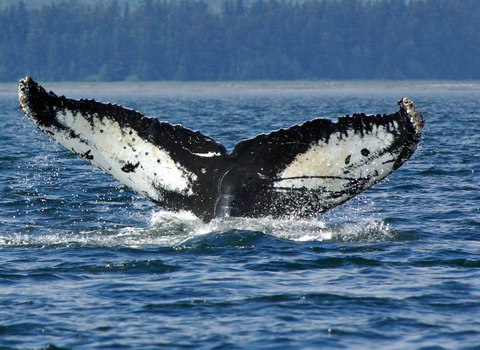
Humpback whale ©Gillian Day
Humpback whale
Scientific name
Megaptera novaeangliaeWhen to see
January to DecemberSpecies information
Category
Statistics
Length: Up to 18m Weight: up to 40 tons Lifespan: 80-90 yearsHabitats
About
The humpback whale is a large baleen whale, reaching up to 18m long. They are found throughout the world's oceans and perform some of the longest migrations of any mammal. They feast on fish and krill in productive cooler waters and then travel to tropical seas to give birth. In UK seas, they are normally spotted alone or in pairs. Look out for the 5m long pectoral fins (front flippers) that give the humpback whale their scientific name: Megaptera novaeangliae - meaning Big-winged New-Englander!How to identify
Humpback whales are unmistakable, thanks to their unique knobbly head and the long wing-like front flippers that they often raise and slap on the surface. Their body is black or dark grey with a white underside. The first sign of a whale is often the blow as they exhale at the surface; in humpback whales the blow is bushy and around 3m high.Distribution
Sporadic sightings around much of the UK, more common off Shetland Isles and Hebrides but increasingly seen in Northern North Sea.In our area
Scilly's seas abound with wildlife, including a variety of cetacean species including common dolphins, harbour porpoises, minke whales and even bigger species like humpback and fin whales. One of the best ways to see marine mammals is to watch from Scilly's many headlands (like Peninnis or Deep Point on St Mary's, Wingletang on St Agnes, Shipman Head Down on Bryher, Castle Down on Tresco or from the Daymark on St Martin's) or to head out on a WiSE accredited boat operator offshore. Cetaceans don't generally come between the islands, so a trip to the Western Rocks, Eastern Isles or beyond will give you the best opportunities to see them. You can also spot plentiful wildlife on the Scillonian III crossing from Penzance with Isles of Scilly Travel.
Humpback whales can be seen sporadically at any time of year, but are most frequently seen in the winter months (from December to March). Always keep an eye out in the summer, though, as they are present throughout the year, along with the bigger fin whales and smaller minke whales.
Did you know?
Using the unique pattern of markings on the underside of its tail fluke, we know that a humpback whale seen feeding off the Shetland Isles has also been recorded in breeding grounds off Guadeloupe in the Caribbean!Scilly's seas abound with wildlife, including a variety of cetacean species including common dolphins, harbour porpoises, minke whales and even bigger species like humpback and fin whales. One of the best ways to see marine mammals is to watch from Scilly's many headlands (like Peninnis or Deep Point on St Mary's, Wingletang on St Agnes, Shipman Head Down on Bryher, Castle Down on Tresco or from the Daymark on St Martin's) or to head out on a WiSE accredited boat operator offshore. Cetaceans don't generally come between the islands, so a trip to the Western Rocks, Eastern Isles or beyond will give you the best opportunities to see them. You can also spot plentiful wildlife on the Scillonian III crossing from Penzance with Isles of Scilly Travel.
Humpback whales can be seen sporadically at any time of year, but are most frequently seen in the winter months (from December to March). Always keep an eye out in the summer, though, as they are present throughout the year, along with the bigger fin whales and smaller minke whales.
